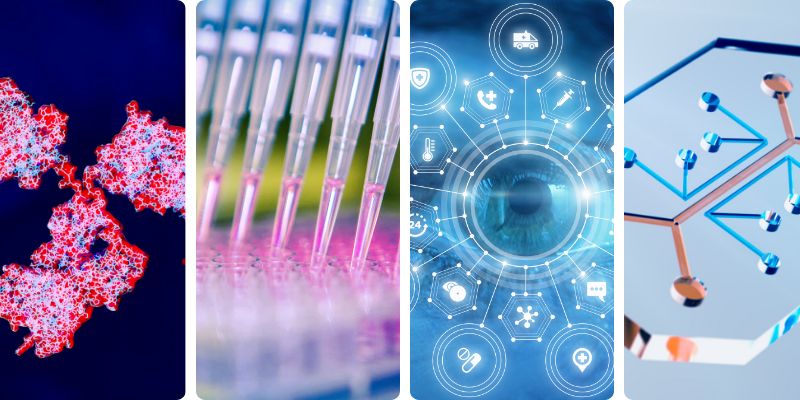
Organoids : A Decade of Transformation, Winners of the HUMAIN Initiative by PCRM and InSphero, and more
News on non-animal methods
Dec. 11 - 15, 2023A Decade of Transformation : How Organoids are Redefining Drug Development
Over the past decade, organoids have become one of the most important scientific advances in biopharma. From their first development in academic labs, they are transitioning to industrial settings where they are harnessed for studying human diseases, tailoring personalized therapies, and reshaping clinical trials. Their use spans a range of applications, including drug screening and intricate disease modeling. As this technology continues to evolve, these 3D systems are increasingly positioned to expedite drug development from laboratory discovery to patient treatment.
Upon their initial discovery over a decade ago, it was expected organoids would be used primarily as “grow-your-own-organs” in the fields of regenerative medicine and tissue engineering. The development of organs-on-a-dish started in 2009 when Sato et al. successfully modeled intestinal tissue using adult stem cells. Intestinal tissue was targeted initially due to the ease of sourcing biopsies, the robust proliferation of intestinal stem cells, and the simplicity of the intestinal epithelium structure compared to other organs.
Over the next four years, academic research expanded the organoid portfolio, developing renal organoids in 2010, cerebral organoids in 2013, liver and pancreatic organoids in 2013, lung organoids in 2014, and mammary gland organoids in 2015. While organoids are able to mimic specific tissue characteristics, they have never reached the full functionality of human organs. Instead, they have experienced a paradigm shift that has expanded their utility far beyond their original scope within regenerative medicine.
Physicians Committee and InSphero Announce Winners of HUMAIN Award
WASHINGTON, D.C. — The Physicians Committee for Responsible Medicine, a nonprofit that advances human-based science, and InSphero, the global leader in 3D in vitro technology for drug safety and efficacy testing, are pleased to announce the winners of the 2023 Human Advanced In Vitro Model Initiative (HUMAIN) Award. The HUMAIN Award recognizes researchers working to expand access to and accelerate the uptake of human-specific nonanimal approaches.
The five awardees of the HUMAIN Initiative are :
Dr. Burak Toprakhisar, Postdoctoral Researcher, Vrije Universiteit Brussel, Belgium — Project Title : Revealing the early cellular events in human liver inflammation by using HiPSC
Dr. Felicia Gerst, Senior Scientist, Université de Tübingen, Germany — Project Title : Impact of pancreatic adipose tissue on islet function
Dr. Gabriela Kania, Principal Investigator, hôpital universitaire de Zürich, Switzerland — Project Title : Exploring liver effects in a multi-organ-on-a-chip model of cardiac fibrosis across diverse experimental scenarios
Dr. Karina Orlowska, Postdoctoral Research Associate, Michigan State University, United States — Project Title : Development of chemical safety screening by high-throughput sequencing
Dr. Ute Wölfle, Principal Investigator and Senior Scientist, Université de Fribourg, Germany — Project Title : Influencing the interaction of fatty liver spheroids and psoriasis keratinocytes by liver-protecting herbal remedies
Replacing mice and improving Glioblastoma outcomes
Professor Anthony Chalmers and Co-Investigator Dr Natividad Gomez-Roman have further developed a 3D human cell culture model replacing the use of mice to evaluate and screen treatments for Glioblastoma (GBM).
GBM is the most common type of brain cancer but patient outcomes remain poor. Tumours are inherently resistant to both chemotherapy and radiotherapy, complicating treatment options. A number of potential new drugs have failed during late-stage clinical trials, suggesting the widely used preclinical screening method, the mouse xenograft model, does not accurately reflect key aspects of human disease.
In vitro alternatives were limited to 2D GBM cultures, which had also failed to improve clinical outcomes. Anthony was awarded an NC3Rs Project grant to further develop a 3D GBM cell culture system and demonstrate its utility for testing new therapeutics. Crucially, the system includes GBM stem-like cells (GSCs), known to contribute to treatment resistance, alongside human brain endothelial cells. This creates a multicellular model of the ‘perivascular niche’ – the microenvironment around blood vessels in the brain in which GBM tumours thrive – which more closely reflects human cancer biology.
Clinical trials in a dish
In a series of rooms in the heart of the Stanford Cardiovascular Institute, incubators the size and shape of a dorm-room refrigerator hum quietly. Inside each, a surprise : hundreds of people.
The incubators house a multitude of palm-sized, clear plastic trays dotted with circular wells, which are filled with liquid ranging from pink to yellowish. Each well contains languidly beating heart cells that genetically match one person who has donated them for research. One person per row ; 96 wells per plate ; 10 to 20 plates per humid, warm incubator shelf ; two to four incubators per room.
For the past decade, researchers in the laboratory of institute director Joseph C. Wu, MD, PhD, have been using these trays of cells to investigate the molecular causes of common heart disorders and test the effects of newly designed drugs on heart and blood vessel cells.
They envision a future where the tray-based screening — a technique that Wu, the Simon H. Stertzer, MD, Professor of medicine and of radiology, calls “clinical trials in a dish” — reduces the need for large-scale, expensive and time-consuming experiments on humans and laboratory animals.


